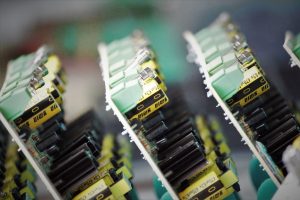Thermal Logic Gates: Heat-Powered Processing
In today’s digital age, the demand for faster and more efficient processing has led to the development of novel technologies. One of the latest breakthroughs is the use of thermal logic gates for heat-powered processing. This innovative approach has the potential to revolutionize the field of computing and open up new possibilities for energy-efficient computing. In this article, we will delve into the concept of thermal logic gates, how they work, and their potential applications in the world of computing.
What are Thermal Logic Gates?
Thermal logic gates are electronic devices that use heat instead of electricity to perform logical operations. They are based on the principle of thermal management, where heat is harnessed and controlled to perform computational tasks. This is in contrast to traditional logic gates, which use the flow of electrons to process and relay information.
An interesting aspect of thermal logic gates is that they are non-volatile, meaning they retain their computational state even when the power is turned off. This is in contrast to traditional logic gates, which require a constant supply of electricity to function. The ability to retain information without power makes thermal logic gates ideal for low-power applications, where energy efficiency is crucial.
How do Thermal Logic Gates Work?
At its core, thermal logic gates rely on the thermal conductivity of materials. Thermal conductivity is the ability of a material to transfer heat. By controlling the flow of heat in different directions, thermal logic gates can perform logical operations. This is achieved by integrating materials with different thermal properties, such as metals and insulators, to form a diode-like structure.
When heat is applied to one end of the device, it creates a temperature gradient that causes the electrons in the material to move in a particular direction. This movement of electrons creates a “thermal current”, which can be interpreted as a digital signal. By controlling the direction of the thermal current, thermal logic gates can perform logical operations, such as AND, OR, and NOT.
Potential Applications of Thermal Logic Gates
The most significant advantage of using thermal logic gates is their low-power consumption. This makes them ideal for use in portable and embedded devices, where energy efficiency is crucial. In the future, thermal logic gates may be used in applications such as wearable technology, internet of things (IoT) devices, and electronic implants.
Another potential application of thermal logic gates is in the field of quantum computing. Thermal logic gates have the potential to solve some of the challenges faced by traditional logic gates in quantum computers. The non-volatile nature of thermal logic gates makes them suitable for use in quantum systems, where maintaining the delicate quantum state is crucial.
Moreover, thermal logic gates can also play a significant role in reducing the carbon footprint of computing. Traditional computing devices generate a considerable amount of heat, which requires additional energy to dissipate. By harnessing this heat to perform computations, thermal logic gates can significantly reduce the energy consumption of computing devices.
Limitations and Future Prospects
Like any emerging technology, thermal logic gates also have their limitations. The most significant challenge lies in achieving sufficient heat flow to perform complex computations. Currently, thermal logic gates can only process simple logic operations, and researchers are working on improving their capabilities. Another limitation is the difficulty in scaling down these devices for use in smaller computing systems.
Despite these challenges, the potential of thermal logic gates is vast. With the increasing demand for energy-efficient computing, researchers continue to explore new techniques to harness heat and use it for processing. With further advancements and innovations, thermal logic gates may become an integral part of computing systems in the near future.
In Conclusion
Thermal logic gates are an exciting new development in the world of computing. By harnessing heat for processing, they offer a novel approach to low-power computation. Their potential applications in various fields, including quantum computing, make them a promising technology for the future. As research in this field continues, we can expect further advancements and innovations in thermal logic gates, bringing us closer to a more energy-efficient computing future.










